*NURSING > QUESTIONS & ANSWERS > Care of Patients with Dysrhythmias: Test Bank: Complete with Answers and Rationale (CHAMBERLAIN) (All)
Care of Patients with Dysrhythmias: Test Bank: Complete with Answers and Rationale (CHAMBERLAIN)
Document Content and Description Below
Care of Patients with Dysrhythmias Test Bank MULTIPLE CHOICE 1. A client’s cardiac status is being observed by telemetry monitoring. The nurse observes a P wave that changes shape in lead II... . What conclusion does the nurse make about the P wave? a. It originates from an ectopic focus. b. The P wave was replaced by U waves. c. It is from the sinoatrial (SA) node. d. Multiple P waves are present. 2. The nurse is assessing the client’s electrocardiography (ECG). What does the P wave on the ECG tracing represent? a. Contraction of the atria b. Contraction of the ventricles c. Depolarization of the atria d. Depolarization of the ventricles 3. A nurse notes that the PR interval on a client’s electrocardiograph (ECG) tracing is 0.14 second. What action does the nurse take? a. Assess serum cardiac enzymes. b. Administer 1 mg epinephrine IV. c. Administer oxygen via nasal cannula. d. Document the finding in the client’s chart. 4. When analyzing a client’s electrocardiograph (ECG) tracing, the nurse observes that not all QRS complexes are preceded by a P wave. What is the nurse’s interpretation of this observa-tion? a. The client has hyperkalemia causing ir-regular QRS complexes. b. Ventricular tachycardia is overriding the normal atrial rhythm. c. The client’s chest leads are not making sufficient contact with the skin. d. Ventricular and atrial depolarizations are initiated from different sites. 5. The nurse observes a prominent U wave on the client’s electrocardiograph (ECG) tracing. What is the most appropriate action for the nurse to take? a. Document the finding as a normal variant. b. Review the client’s daily electrolyte re-sults. c. Move the crash cart closer to the client’s room. d. Call for an immediate electrocardiogram. 6. The client’s heart rate increases slightly during inspiration and decreases slightly during expiration. What action does the nurse take? a. Evaluate for a respirator disorder. b. Assess the client for chest pain. c. Document the finding in the chart. d. Administer antidysrhythmic drugs. 7. A client with tachycardia is experiencing clinical manifestations. Which manifestation requires immediate intervention by the nurse? a. Mid-sternal chest pain b. Increased urine output c. Mild orthostatic hypotension d. P wave touching the T wave 8. A client is experiencing sinus bradycardia with hypotension and dizziness. What medication does the nurse administer? a. Atropine (Atropine) b. Digoxin (Lanoxin) c. Lidocaine (Xylocaine) d. Metoprolol (Lopressor) MSC: Integrated Process: Nursing Process (Implementation) 9. A client experiences occasional premature atrial contractions (PACs) accompanied by palpitations that resolve spontaneously without treatment. What instruction does the nurse in-clude in the client’s teaching plan? a. “Minimize or abstain from caffeine.” b. “Lie on your side until the attack sub-sides.” c. “Use your oxygen when you experience PACs.” d. “Take quinidine (Cardioquin) daily to prevent PACs.” 10. The nurse identifies a client’s rhythm to be a sustained supraventricular tachycardia. What medication does the nurse administer? a. Atropine (Atropine) b. Epinephrine (Adrenalin) c. Lidocaine (Xylocaine) d. Diltiazem (Cardizem) 11. A client has a heart rate averaging 56 beats/min with no adverse symptoms. What activity modifications does the nurse suggest to avoid further slowing of the heart rate? a. “Make certain that your bath water is warm (100° F).” b. “Avoid bearing down or straining while having a bowel movement.” c. “Avoid strenuous exercise, such as run-ning, during the late afternoon.” d. “Limit your intake of caffeinated drinks to no more than 2 cups per day.” 12. The nurse is assessing clients at a community clinic. Which client does the nurse assess most carefully for atrial fibrillation? a. Middle-aged client who takes an aspirin daily b. Client who is dismissed after coronary artery bypass surgery c. Older adult client after a carotid endarter-ectomy d. Client with chronic obstructive pulmonary disease 13. The nurse is caring for a client on a cardiac monitor. The monitor shows a rapid rhythm with a “saw tooth” configuration. What physical assessment findings does the nurse expect? a. Presence of a split S1 and wheezing b. Anorexia and gastric distress c. Shortness of breath and anxiety d. Hypertension and mental status changes 14. The nurse is caring for a client with atrial fibrillation. What manifestation most alerts the nurse to the possibility of a serious complication from this condition? a. Sinus tachycardia b. Speech alterations c. Fatigue d. Dyspnea with activity 15. The nurse is caring for a client with chronic atrial fibrillation. Which drug does the nurse expect to administer to prevent a common complication of this condition? a. Sotalol (Betapace) b. Warfarin (Coumadin) c. Atropine (Atropine) d. Lidocaine (Xylocaine) 16. The nurse is caring for a client admitted for myocardial infarction. The client’s monitor shows frequent premature ventricular contractions (PVCs). What dysrhythmia does the nurse remain alert for? a. Sinus tachycardia b. Rapid atrial flutter c. Ventricular tachycardia d. Atrioventricular junctional rhythm 17. A client with myocardial ischemia is having frequent early, wide ventricular complexes seen on the cardiac monitor. Which medication does the nurse administer? a. Lanoxin (Digoxin) b. Amiodarone (Cordarone) c. Dobutamine (Dobutamine) d. Atropine sulfate (Atropisol) 18. The nurse has administered adenosine (Adenocard). What is the expected therapeutic response? a. Increased intraocular pressure b. A brief tonic-clonic seizure c. A short period of asystole d. Hypertensive crisis 19. A client’s electrocardiograph (ECG) tracing shows a run of sustained ventricular tachycardia. What is the nurse’s first action? a. Assess airway, breathing, and level of consciousness. b. Administer an amiodarone bolus followed by a drip. c. Cardiovert the client with a biphasic de-fibrillator. d. Begin cardiopulmonary resuscitation (CPR). 20. A client with unstable ventricular tachycardia is receiving amiodarone by intravenous infusion. The nurse notes that the client’s heart rate has decreased from 68 to 50 beats/min. The client is asymptomatic. What is the nurse’s priority intervention? a. Stop the infusion and flush the IV. b. Slow the amiodarone infusion rate. c. Administer a precordial thump. d. Place the client in a side-lying position. 21. A client with ischemic heart disease has an electrocardiograph (ECG) tracing that shows a PR interval of 0.24 second. What is the nurse’s best action? a. Document the finding in the chart. b. Measure blood pressure. c. Notify the health care provider. d. Administer oxygen. 22. The physician is about to perform carotid sinus massage on a client with supraventricular tachycardia. What equipment is most important for the nurse to have ready? a. Emesis basin b. Magnesium sulfate c. Resuscitation cart d. Padded tongue blade 23. The nurse is caring for a client with a complete heart block (third-degree atrioventricular [AV] block). What is the nurse’s priority intervention? a. Perform a cardioversion. b. Assist with carotid massage. c. Begin external pacing. d. Administer adenosine (Adenocard) IV. 24. A client with third-degree heart block is admitted to the telemetry unit. The nurse observes wide QRS complexes on the monitor with a heart rate of 35 beats/min. What priority assessment does the nurse perform? a. Pulmonary auscultation b. Pulse strength and amplitude c. Level of consciousness d. Mobility and gait stability 25. The nurse is caring for a client with a temporary pacemaker. The client’s bedside monitor shows a spike followed by a QRS complex. What is the nurse’s best action? a. Remove the pacemaker; it is not needed. b. Decrease the threshold of the pacemaker. c. Document the finding in the client’s chart. d. Set the pacemaker to the synchronous mode. 26. A client with ventricular tachycardia (VT) is unresponsive and has no pulse. The nurse calls for assistance and a defibrillator. What is the nurse’s priority intervention while waiting for the defibrillator to arrive? a. Perform a pericardial thump. b. Initiate cardiopulmonary resuscitation. c. Start an 18-gauge IV in the antecubital. d. Ask the client’s family about code status. 27. A client has an epicardial pacemaker. The nurse observes the presence of a pacing spike but no QRS complex on the client’s electrocardiograph (ECG) tracing. How does the nurse in-terpret this event? a. Loss of capture b. Ventricular fibrillation c. Failure to sense d. A normal tracing 28. The nurse is assisting with resuscitation of a client. What priority intervention does the nurse perform before defibrillating a client? a. Make sure the defibrillator is set to the synchronous mode. b. Deliver a precordial thump to the upper portion of the sternum. c. Test the equipment by delivering a smaller shock at 100 J. d. Ensure that all personnel are clear of con-tact with the client and the bed. 29. The nurse is recovering a client after insertion of an implantable cardioverter-defibrillator (ICD). What complication must the nurse intervene for immediately? a. 2/4 bilateral peripheral edema b. Heart rate of 56 beats/min c. Temperature of 96° F (35.5° C) d. Muffled heart sounds 30. A client was admitted for a permanent pacemaker insertion. What priority instruction does the nurse include in the client’s discharge teaching? a. “Do not submerge your pacemaker, take only showers.” b. “Report pulse rates lower than your pacemaker setting.” c. “If you feel weak, apply pressure over your generator.” d. “Have your pacemaker turned off before having an MRI.” 31. The nurse is providing discharge instructions for a client with an implantable cardiovert-er-defibrillator (ICD). What statement by the client indicates a good understanding of the in-structions? a. “I should wear a snug-fitting shirt over the ICD.” b. “I will avoid sources of strong electro-magnetic fields.” c. “I can’t perform activities that increase my heart rate.” d. “Now I can discontinue my antidysrhyth-mic medication.” 32. A nurse assesses the following electrocardiography (ECG) strip from a client’s telemetry monitor. What does the nurse chart as the client’s ventricular heart rate? a. 40 beats/min b. 80 beats/min c. 120 beats/min d. 160 beats/min 33. The nurse is assessing a client’s ECG. What is the nurse’s interpretation of the following ECG strip? a. Sinus rhythm with premature ventricular contractions (PVCs) b. Ventricular tachycardia c. Ventricular fibrillation d. Sinus rhythm with premature atrial con-tractions (PACs) 34. The nurse notes the following rhythm on a client’s telemetry monitor. How does the nurse interpret these findings? a. Ventricular tachycardia b. Second-degree heart block c. Supraventricular tachycardia d. Premature ventricular contractions 35. A nurse assesses the following ECG strip from a client’s telemetry monitor. What does the nurse do next? a. Measure hourly urine output. b. Assess the client’s vital signs. c. Administer 0.5 mg atropine IV. d. Prepare for external pacing. 36. The nurse is alerted to a client’s telemetry monitor. After assessing the following ECG, what is the nurse’s priority intervention? a. Start a large-bore IV. b. Administer atropine. c. Prepare for intubation. d. Perform defibrillation. MULTIPLE RESPONSE 1. A client has a consistently regular heart rate of 128 beats/min. Which related physiologic alterations does the nurse assess for? (Select all that apply.) a. Decrease in cardiac output b. Increase in cardiac output c. Increase in blood pressure d. Decrease in blood pressure e. Increase in urine output [Show More]
Last updated: 1 year ago
Preview 1 out of 16 pages
Instant download
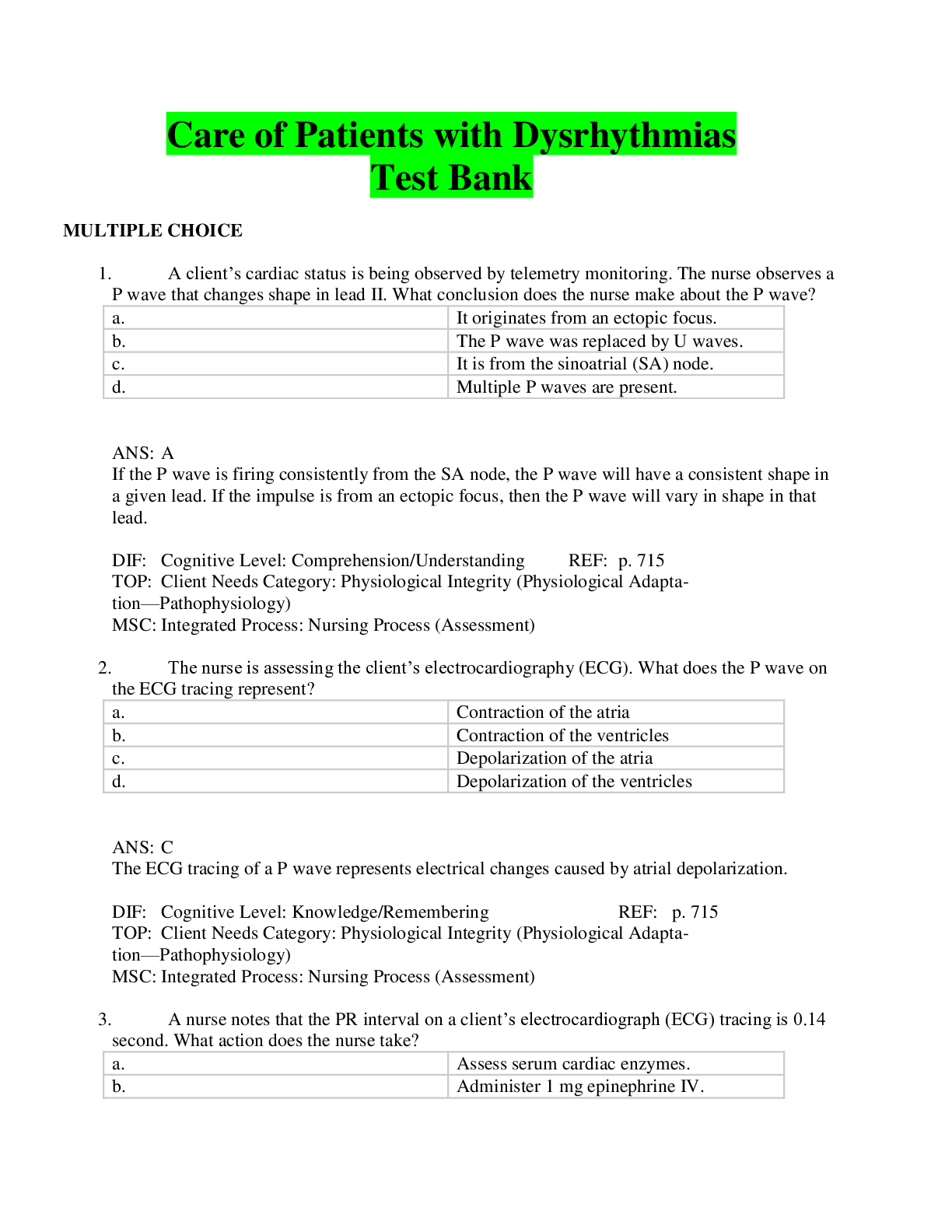
Buy this document to get the full access instantly
Instant Download Access after purchase
Add to cartInstant download
Reviews( 0 )
Document information
Connected school, study & course
About the document
Uploaded On
May 02, 2020
Number of pages
16
Written in
Additional information
This document has been written for:
Uploaded
May 02, 2020
Downloads
0
Views
55














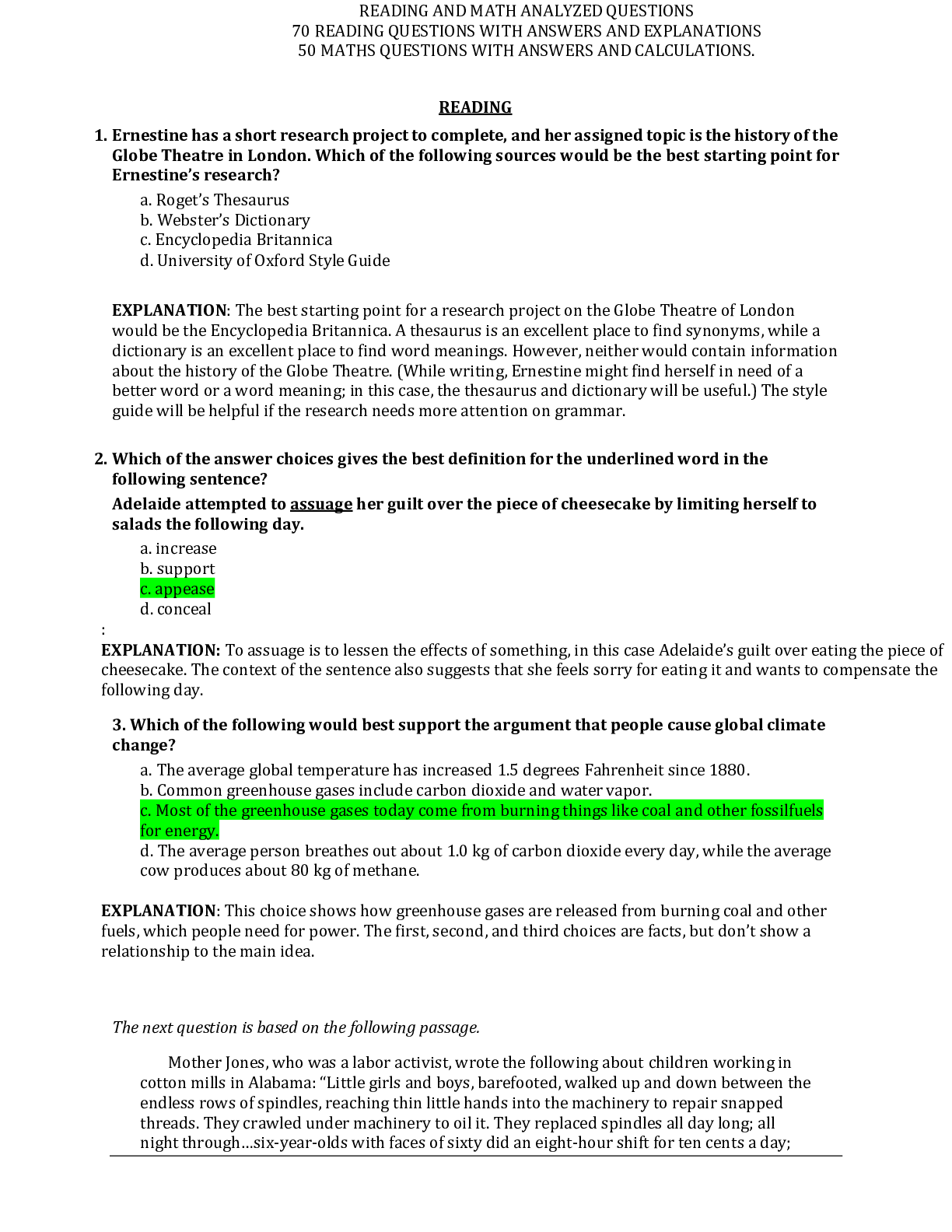

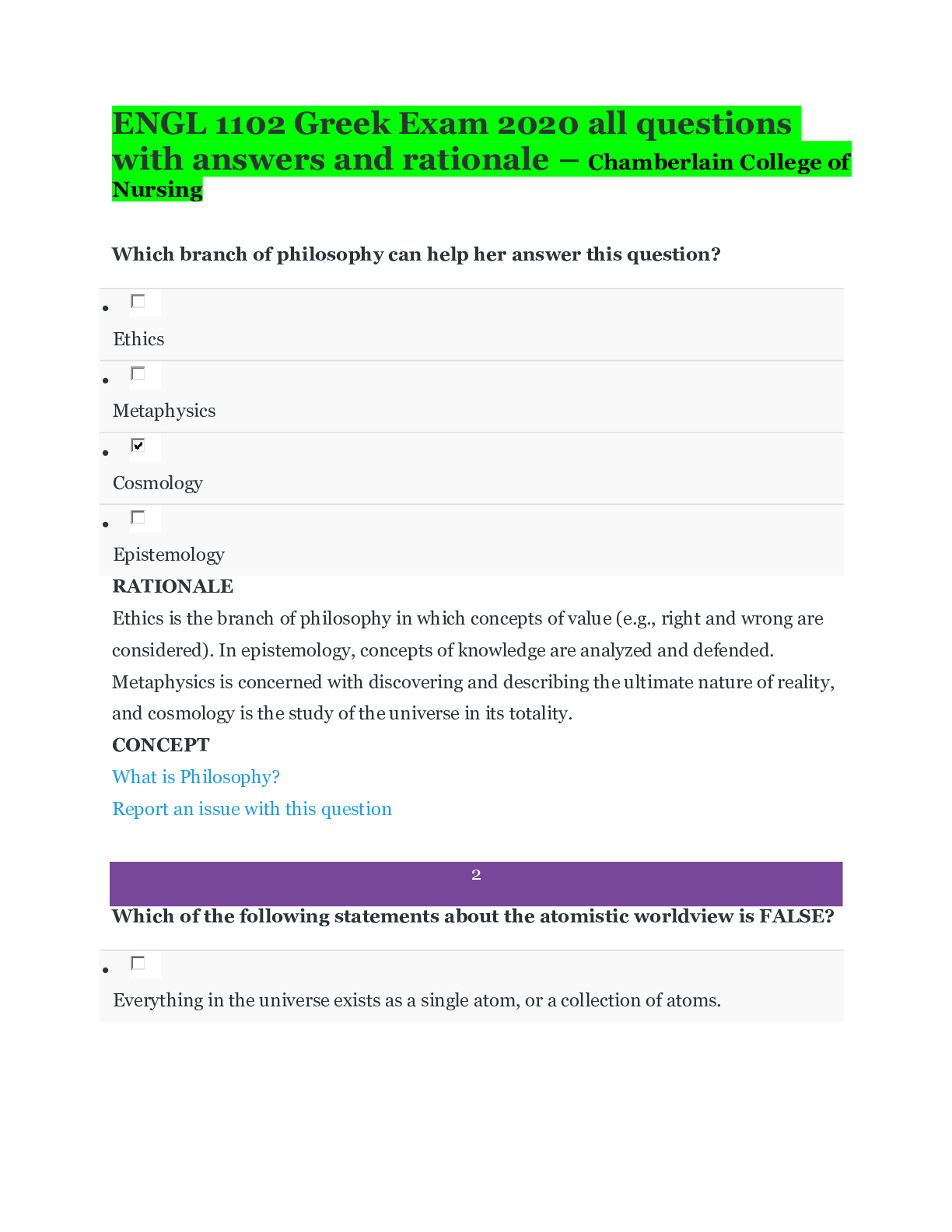
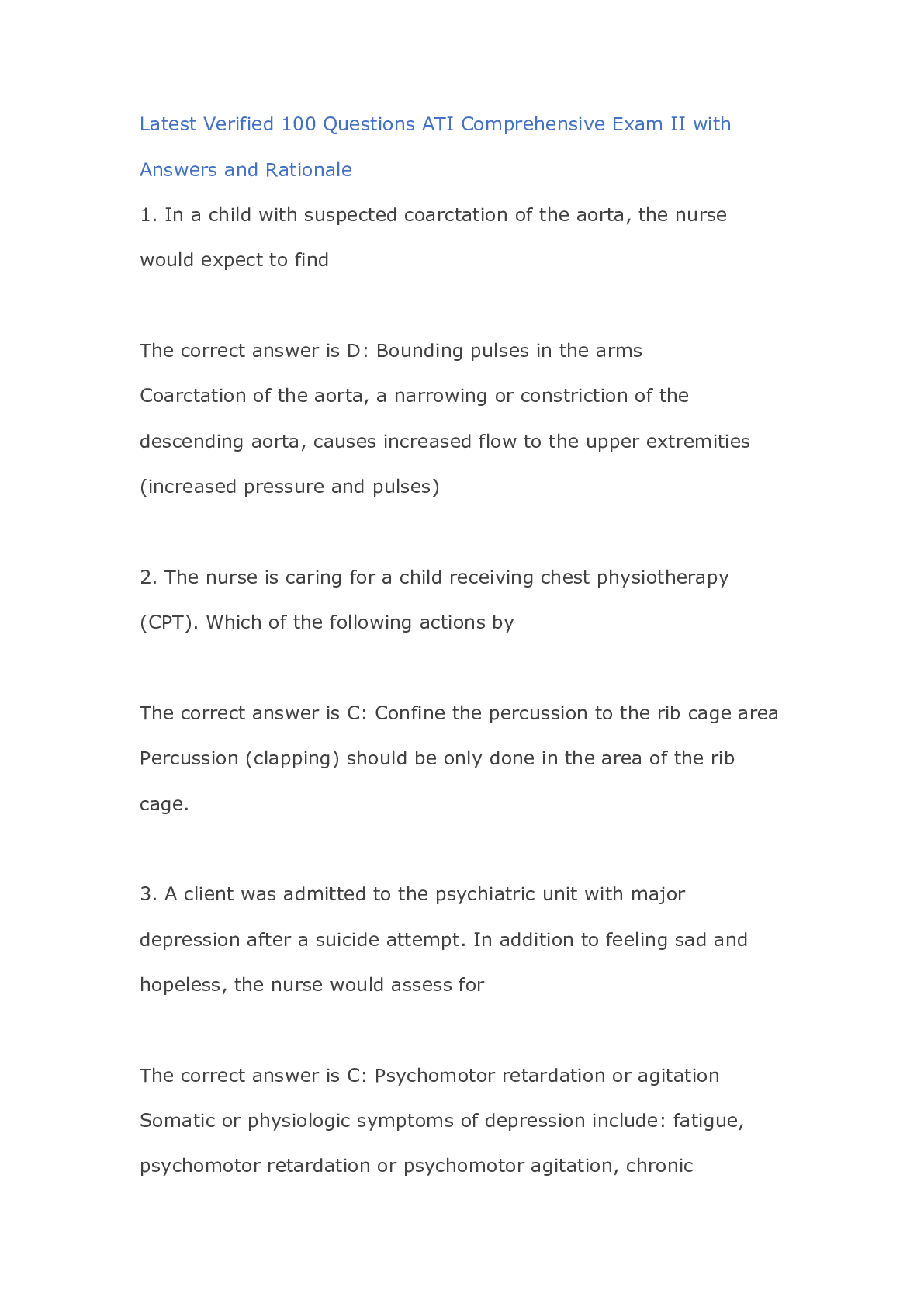
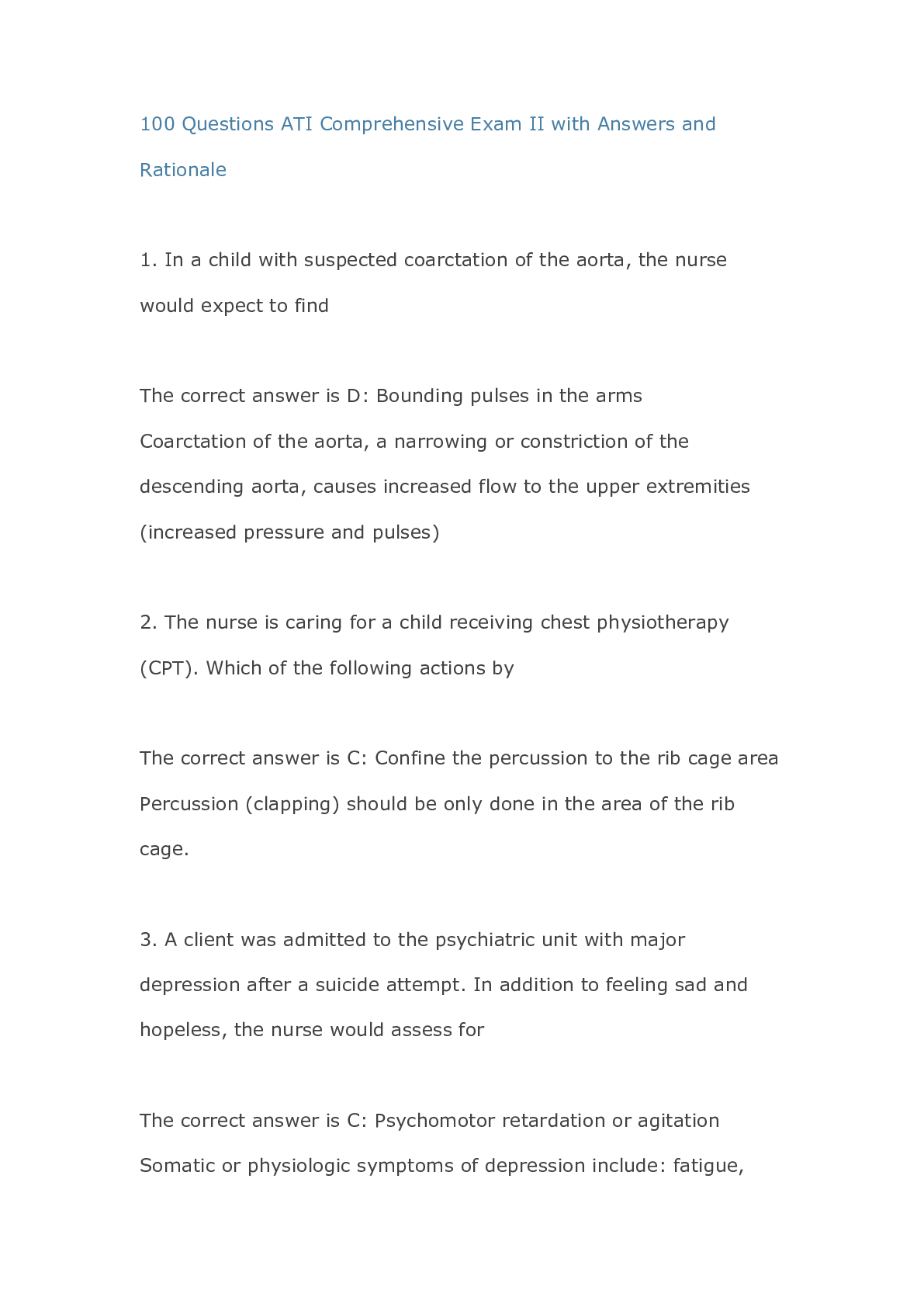
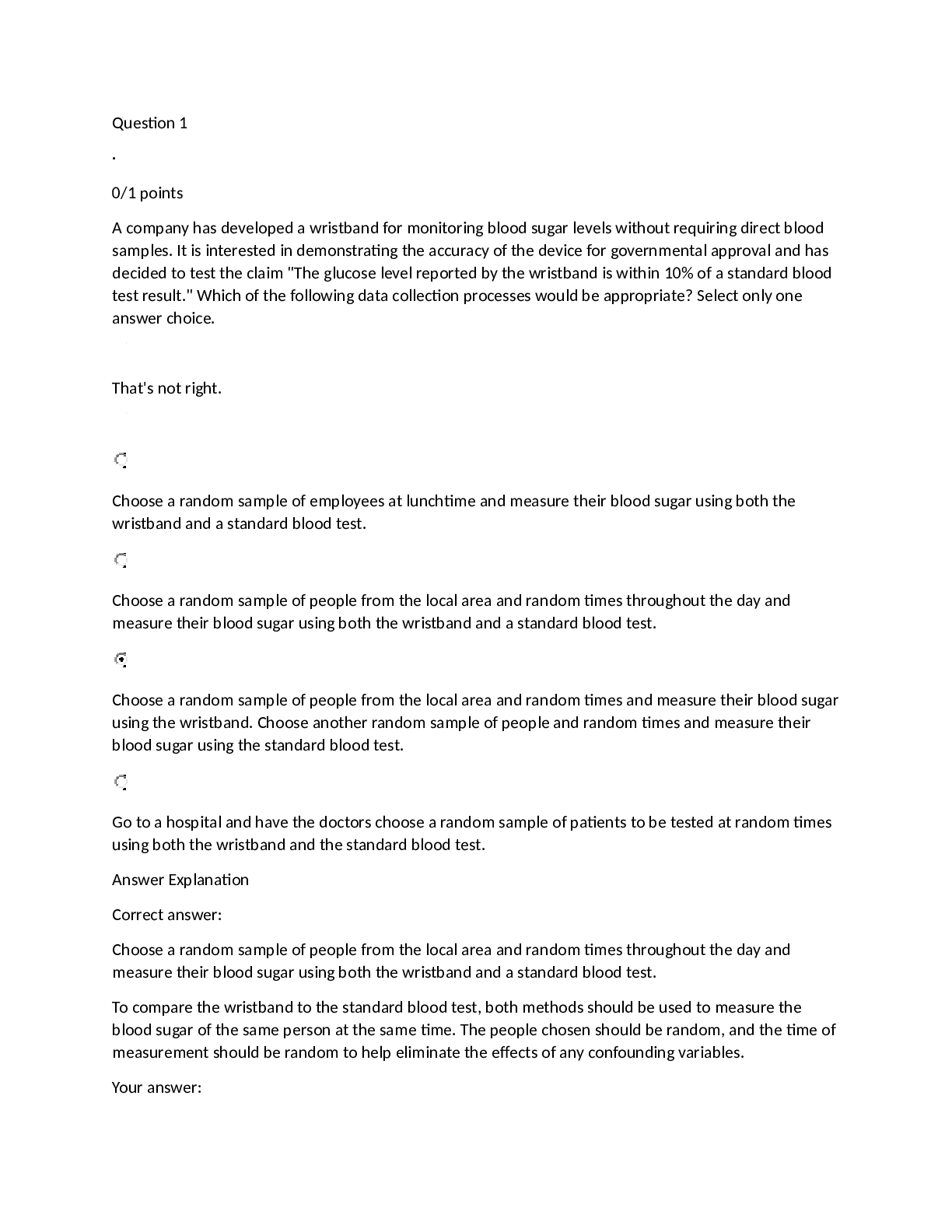
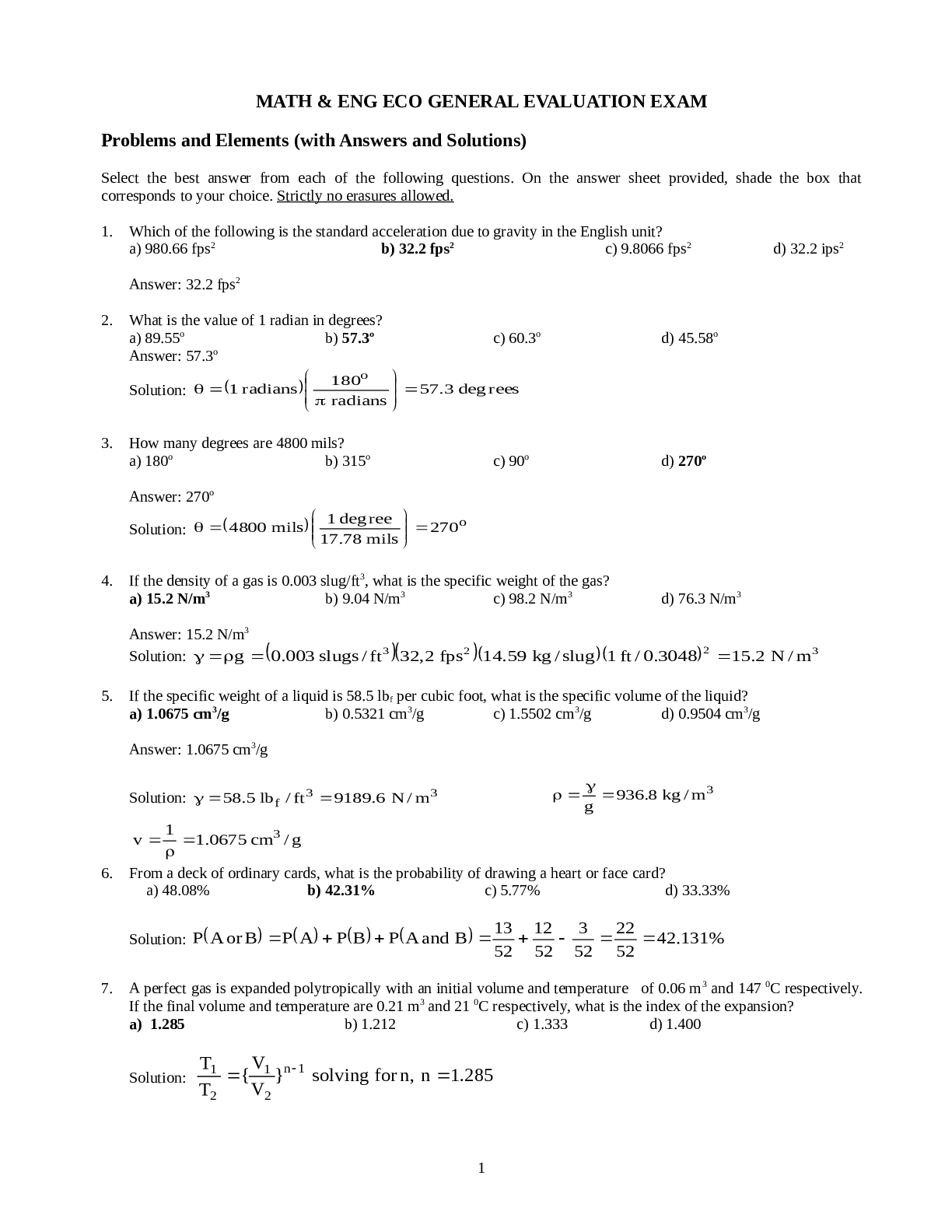
 Revised Exam Prep Guide.png)
 Exam Prep Guide.png)

